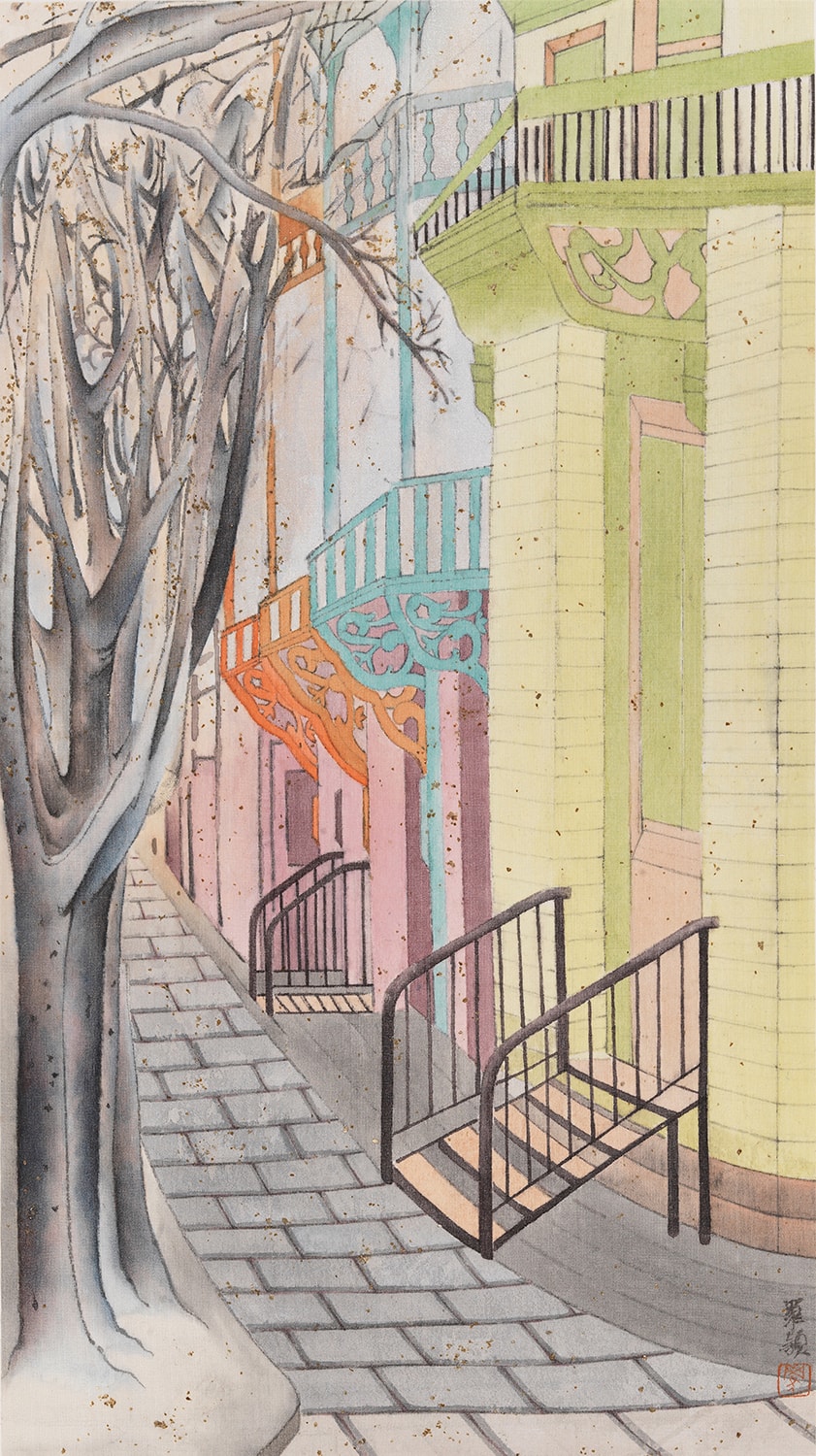Shows
Luo Ying’s “Layered Hills”


Two pots of lotus flowers greeted visitors of Luo Ying’s “Layered Hills”; behind them were four horseshoe-back armchairs. All around, pottery, plants and scholar’s rocks dotted the gallery space. Even with the glass-framed scrolls and canvases, Hanart TZ looked as much like a set for a period drama as an art gallery. The solo exhibition showcased a number of landscape paintings by Luo, ranging from conventional gongbi to experimentations with Western motifs.

The final character in the Chinese title of the exhibition, ji (記), meaning “tales”—as in “Tales of the Layered Hills,” rather than simply “Layered Hills”—conveys the mythical quality of these artworks. In the titular 2016 series, gnarled pines envelop what appear to be Taihu rocks but could also be imposing, weathered hills. The surface of the rock, alternating between creased and wrinkled and marble-smooth, is deftly rendered through variations of fine line and boneless washes of ink. The “Miniature Landscape” and “Eight Scenic Views of Yongfu Monastery” series (both 2017) transport the viewer into a long-gone pastoral landscape, where days could be spent philosophizing on the beauty of nature. Or these days may not have existed at all. One of the "Miniature Landscape" pieces shows a dragon entangled in clouds, rendered in such lifelike detail that you could almost hear the thunder clap over the rippling waves of the sea, serving as a reminder that all of this, painted in the 21st century, rarely belongs outside the realm of imagination.
Compositions in Chinese ink paintings are organized by individual elements, so figure-ground relationship may be present but is unnecessary. The foot of a mountain that fades into nothing is understood to be obscured by fog, and overlapping layers of hills demarcate recession. Luo toys with this property in her “Elegant Offering” series (2014), where there are no backgrounds but washes of pastel colors, which at once delineate water, the ground or the sky. Nos. 9 and 10 of the series, presented as a diptych, both depict Taihu rocks surrounded by swathes of soft pink. In No. 9, a butterfly perched on top of the rock suggests that the pink represents the sky, yet in No. 10, a fish swimming towards an
azalea indicates that the same color represents water.


Reflected in almost every aspect of each work, from the overall aesthetic to the medium to the color palette, is Luo’s negotiation between Chinese and global, the traditional and the contemporary—a tension that extends beyond art history to China’s socioeconomic development at large. As if adjusting to the general population’s preference for flashier things (though Luo still takes a relatively minimalistic approach to color), she juxtaposes subdued tones with attention-grabbing shocks of blues, greens and whites more fitting in a Japanese ukiyo-e print. In Street (2013), for instance, calligraphic trees of the Old Masters appear on the streets of Paris, lined up cheek by jowl along a linear perspective. No longer gnarled and twisted, they jut out at odd angles, bending into awkward shapes. Straddling two vastly different sets of visual vocabulary, the painting loses the dynamism and vivacity of guohua, and scarcely achieves the trompe l’oeil effect that pre-modernist Western art mostly aims for. Yet, Luo’s paintings of European architecture are only startling in that they are on the precipice of creating a new form of representation that meets the demands of a changing landscape.
While shouldering the legacy of ancient giants in Chinese art, Luo also tasks herself with transplanting its beauty into the modern world. In “Layered Hills,” the amalgamation of Western one-point perspective and Chinese orthographic perspective gave the paintings an untutored look, despite the fact that Luo is evidently an accomplished artist. While the techniques of guohua are the product of refinement over thousands of years, ancient gardens and mythical landscapes as subject matters look only to the past, and in doing so, struggle to remain relevant in this day and age. Luo may have yet to perfect the approach to representing the globalized world through the lens of guohua, but her works display an undeniable potential to bring Chinese art to new and exciting places.
Phoebe Tam is an editorial intern of ArtAsiaPacific.
Luo Ying’s “Layered Hills” is on view at Hanart TZ Gallery, Hong Kong, until August 25, 2018.







